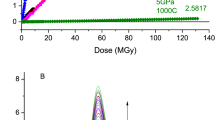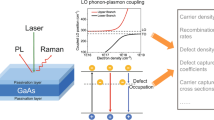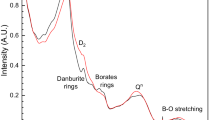Abstract
IN attempts to explain the process of coloration of glass by γ-radiation, it was suggested in a previous communication1 that electrons are trapped in defects to form colour centres. Not only do these defects already exist in glass but they can also be created by exposure to radiation. If defects could not be so created, it would be expected that the concentration of colour centres, as measured by the optical density, would increase exponentially to a saturation value at a certain dose. In practice, it is found that the optical density increases exponentially with dose up to about 105.5 rads, but thereafter the increase is linear. This effect is shown in Fig. 1, which is divided into two sections having different scales for dose, the first section illustrating the exponential portion and the second the linear portion of the curve.
This is a preview of subscription content, access via your institution
Access options
Subscribe to this journal
Receive 51 print issues and online access
$199.00 per year
only $3.90 per issue
Buy this article
- Purchase on SpringerLink
- Instant access to full article PDF
Prices may be subject to local taxes which are calculated during checkout
Similar content being viewed by others
References
Barker, R. S., Richardson, D. A., McConkey, E. A. G., and Rimmer, R., Nature, 187, 135 (1960).
Author information
Authors and Affiliations
Rights and permissions
About this article
Cite this article
BARKER, R., RICHARDSON, D., McCONKEY, E. et al. Radiation-induced Defects in Lead Silicate Glass. Nature 188, 1181 (1960). https://doi.org/10.1038/1881181a0
Issue date:
DOI: https://doi.org/10.1038/1881181a0



